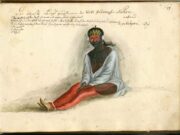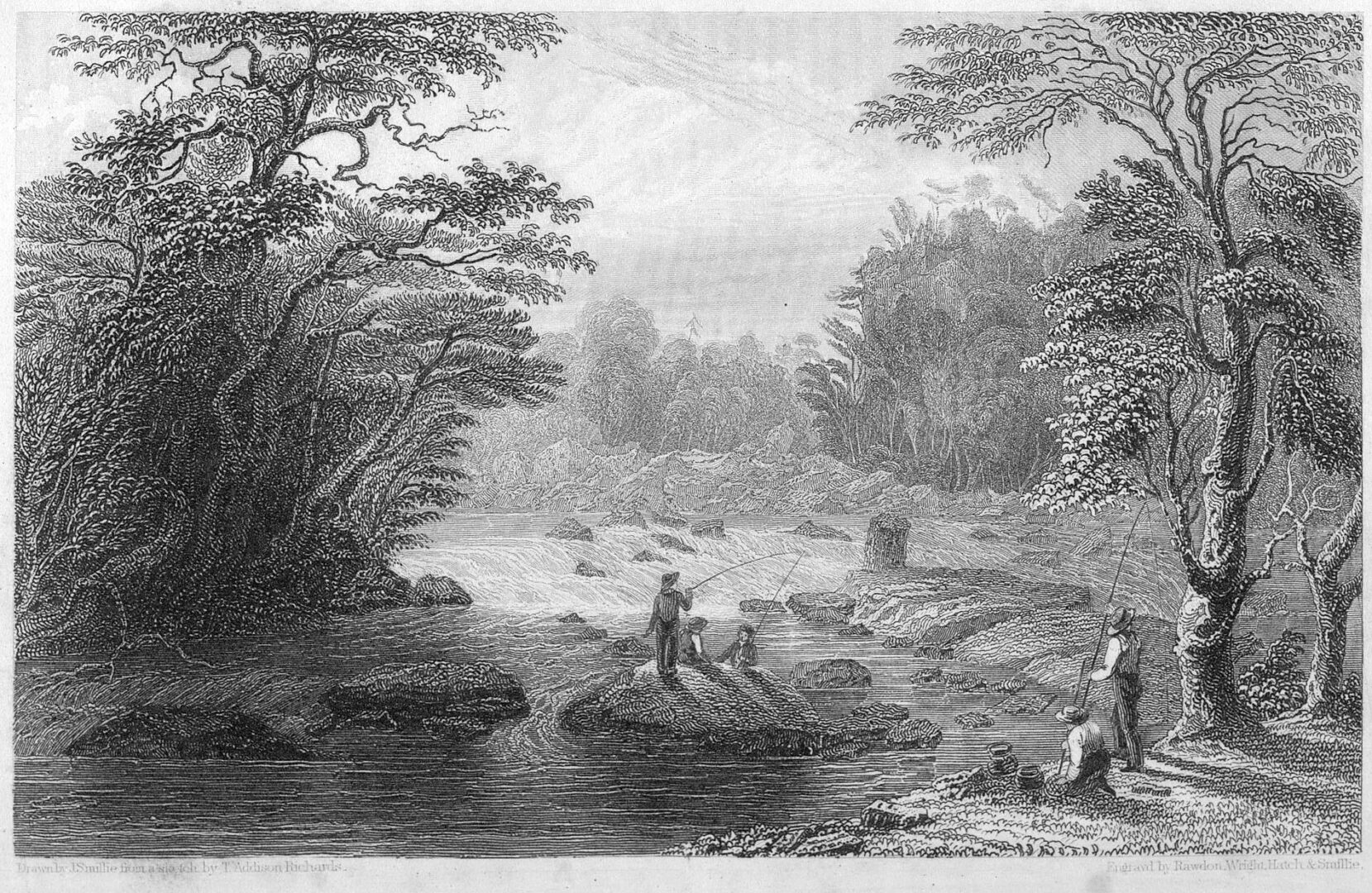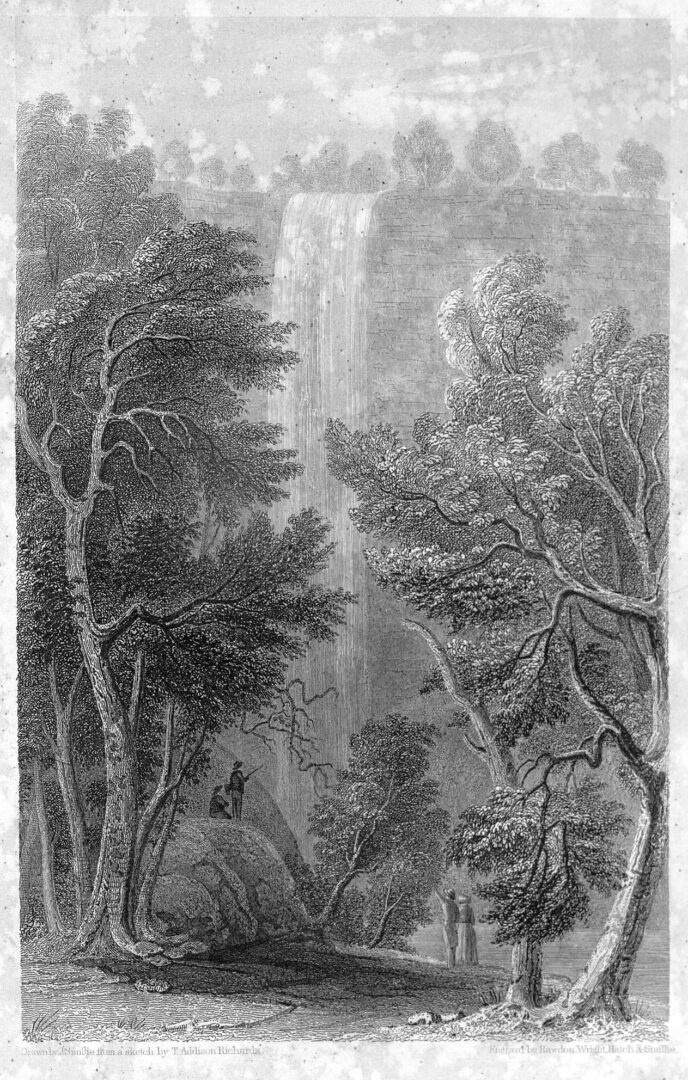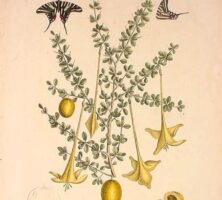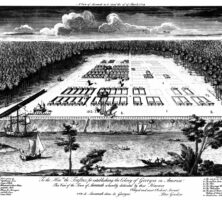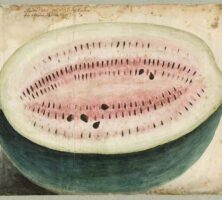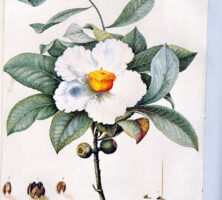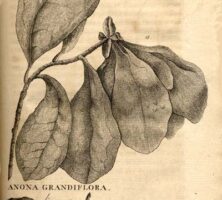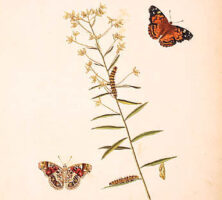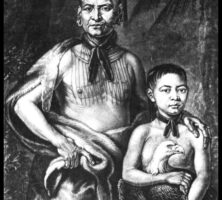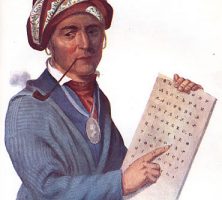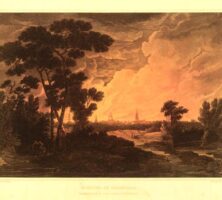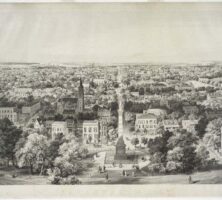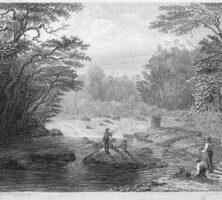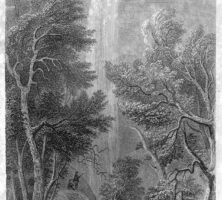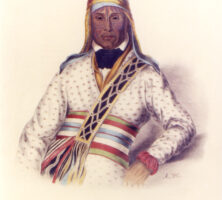Georgia artwork from the eighteenth and nineteenth centuries is typically covered in larger histories of southern art, where painting, architecture, and/or decorative arts dominate, and a few valuable studies are available on individual artists who made early drawings and prints involving Georgia.
Although a published history of the drawings and prints of Georgia made during this time does not exist, these vivid works, as well as their creators, are worthy of study in their own right as early documentation of the colony and the state.
A range of artists, through their involvement in the picture making of Georgia, made significant contributions to the history of American prints and drawings. Their efforts, which are tied to larger artistic worlds in America and abroad, comprise four major spheres of artistic interest: records of the New World, portraiture, landscape and city views, and illustrations for popular books and magazines.
Visual Records of Georgia in the Eighteenth Century
During the eighteenth century the South attracted several expeditions that studied natural history subjects, recorded new settlements, and produced drawings and prints that are significant for the early history of Georgia and natural history illustration.
Mark Catesby
Mark Catesby, during the early eighteenth century, documented natural history subjects in drawings that form essential records of wildlife and plant life in the southern British colonies. Catesby made the first major natural history drawings of wildlife and their habitats in or near the future state of Georgia. During his Carolina tour of 1722 to 1726 he traveled three times to Fort Moore, an outpost on the Savannah River near Augusta.
On this tour, endorsed by the venerable Royal Society in London, England, Catesby made fine, delicate drawings of animals and plants, which emphasize the general look of a species. He worked in watercolor and gouache (an opaque watercolor) over lines made with either brown ink or pencil, and sometimes both. Back in London, finding that the Royal Society could not publish his notes and drawings, he secured financing and learned how to etch and make prints after his sketches. Catesby’s Natural History of Carolina, Florida, and the Bahama Islands was published in 1731-32 (vol. 1) and 1743 (vol. 2). The 220 etchings of birds, plants, trees, snakes, and other subjects were based on carefully executed preparatory drawings made, in part, on the expeditions to Fort Moore. The drawings are stored at the Royal Library in London.
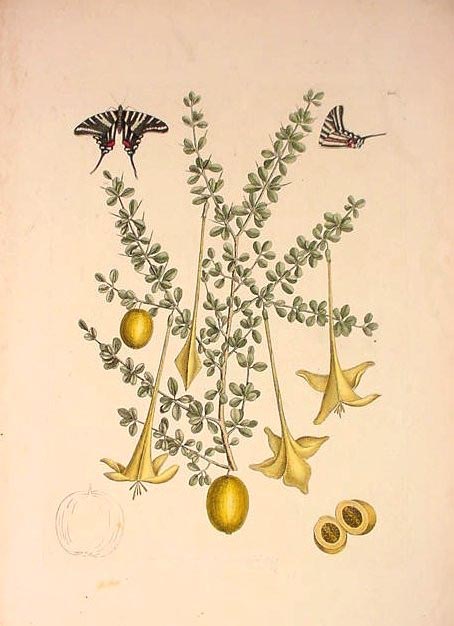
Paul Fourdrinier
In 1734 a professional printmaker, Paul Fourdrinier, who worked in London, made an engraved and etched print showing the developing Savannah. The engraving, based on an earlier plat probably made by the Savannah surveyor Noble Jones, is the first known plan of the city. “A View of Savannah as it Stood the 29th of March 1734” shows the gridlike layout of the port town upon a bluff overlooking the river, with the background cloistered by a dense forest of trees. At the time, such bird’s-eye views, based on the seventeenth- and eighteenth-century English topographical tradition of depicting sweeping views of cities and their natural surroundings, were fashionable in Europe. Later in the century, Savannah became the subject of further European prints, including an engraving after French artist Claude Joseph Vernet that was made around 1775-83. Apparently taking advantage of pro-American interest among the French, Vernet based his print of Savannah on a European view he had painted earlier, a sea scene with architectural ruins.
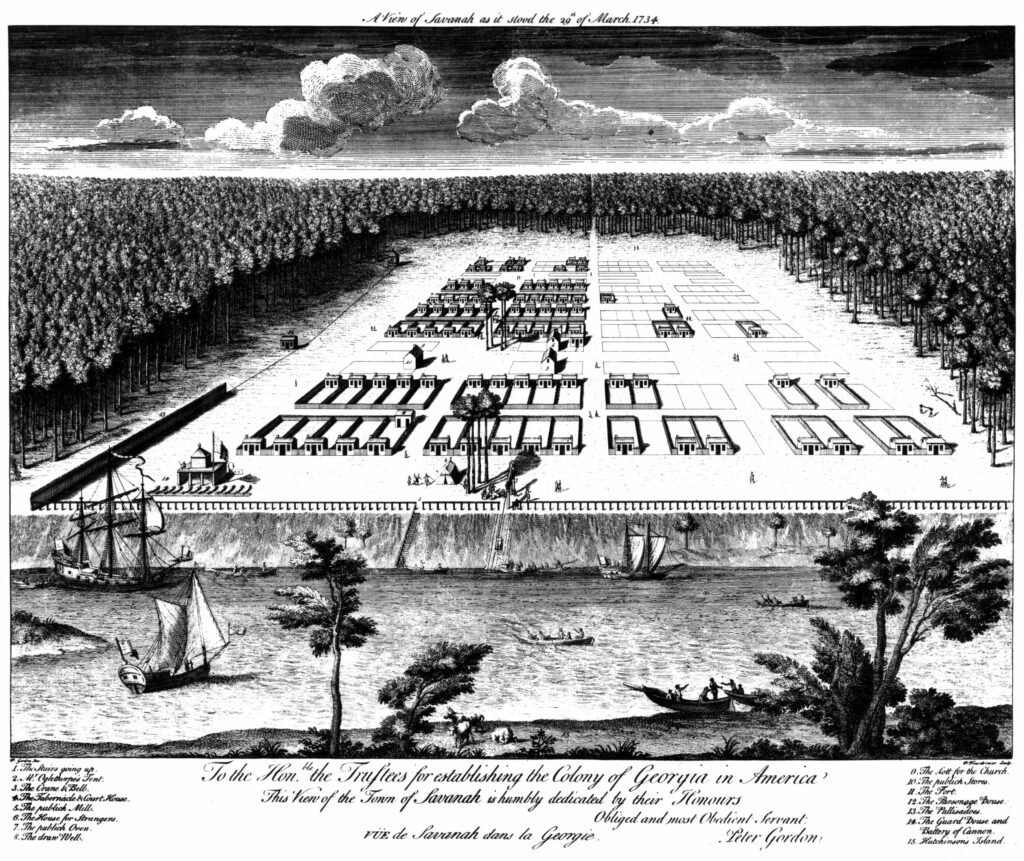
Philip Georg Friedrich von Reck
In 1736 the German artist Philip Georg Friedrich von Reck traveled to Ebenezer, a settlement north of Savannah that had been founded two years earlier by Protestants expelled from Salzburg, Germany. Shortly thereafter, the Salzburg settlement was moved to a nearby site, called New Ebenezer, which became commercially active. The Royal Library in Copenhagen, Denmark, holds about fifty vivid documentary watercolor-and-pencil sketches, attributed to Von Reck, of New Ebenezer, the Creek and Yuchi Indians, and local plant and animal life.
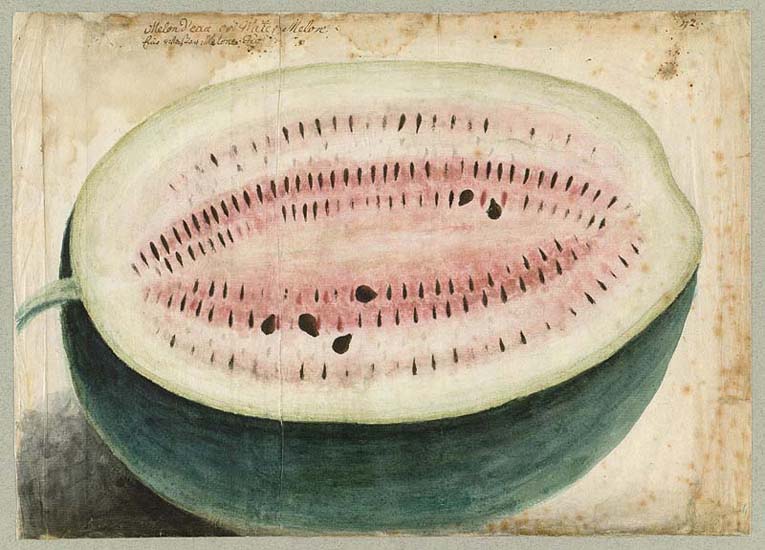
William Bartram
In the second half of the eighteenth century, interest in recording natural history subjects in Georgia revived. In 1765-66 the artist and naturalist William Bartram of Philadelphia, Pennsylvania, joined his father, John Bartram, botanist to King George III, on a trip to North and South Carolina, Georgia, and Florida. From 1773 to 1777 the young Bartram traveled by himself in the Southeast, collecting and shipping seeds and plants and making drawings of local plants, animals, and shells for his sponsor in England. The long trip included intermittent but lengthy periods in Georgia.
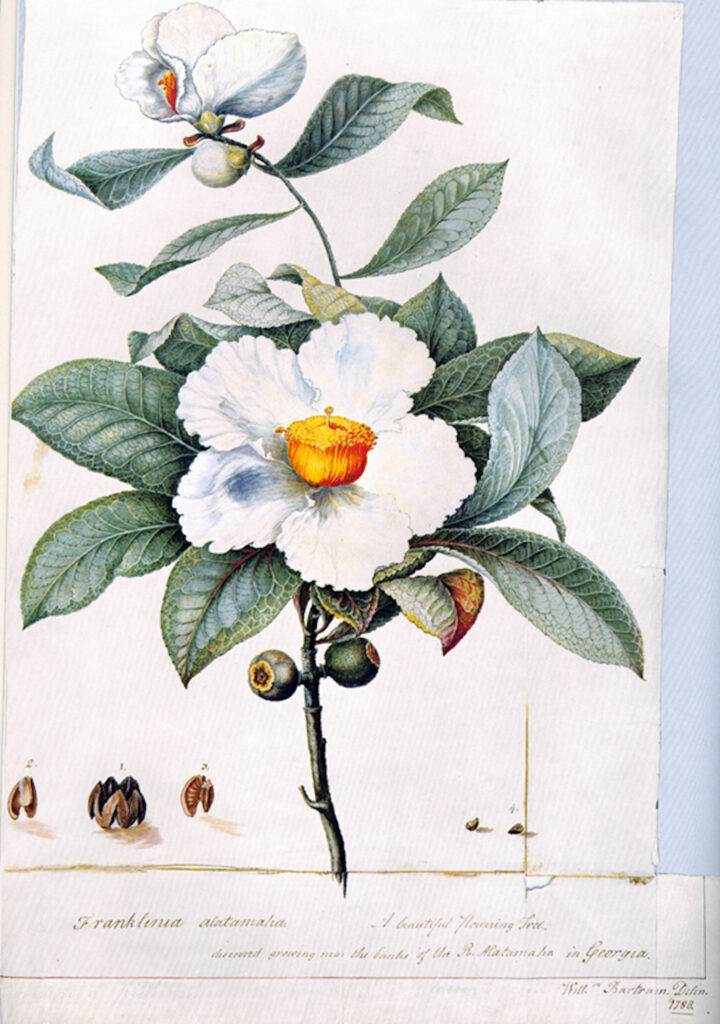
In May 1773 Bartram arrived in Savannah and then traveled far inland, up to Madison and Hart counties; he probably spent the fall close to or in Savannah. In spring 1774 he was in Darien, south of Savannah, and by July 1775 he was at Rock Landing, near Milledgeville in middle Georgia, before traveling on to Louisiana. By January 1776 Bartram was back in Georgia and had reached the Ocmulgee River. After a stint as a volunteer with General Lachlan McIntosh during the summer, he was traveling by the end of July on the Altamaha River in south Georgia. By early 1777 he was back in Philadelphia.
Bartram’s solo trip was sponsored by the physician and botanist John Fothergill, a patron of Catesby’s from Great Britain who owned a large botanical garden at Upton in Essex, England, where plants from America are said to have flourished. Bartram’s drawings from an album belonging to Fothergill are in the collection of the Natural History Museum in London. Most of these contour line drawings seem to have been sketched first in graphite; the lines were then covered with thin, delicate lines of ink. Shadows and a three-dimensional quality are suggested by gently drawn marks that are stacked or crossed as in engravings, though these drawings were never made into prints.
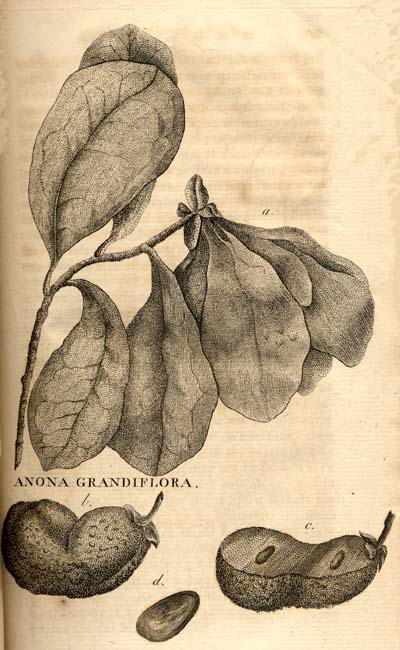
Other drawings were hand colored with what appear to be watercolor and gouache. Rendered starkly against the white of the paper, Bartram’s drawings, especially those in pencil and ink, emphasize distinct forms of individual plants and animals—the gentle, curving taper of particular leaves of fly poison, for instance; or the stiff, hooded throat of a pitcher plant; or the tubular, snoutlike nose of a soft-shelled turtle. All are individual portraits, many with a fantastic quality that distinguishes them from the uniformity and patterning that is characteristic of conventional natural-history illustration.
Bartram’s book Travels through North and South Carolina, Georgia, East and West Florida, the Cherokee Country, the Extensive Territories of the Muscogulges, or the Creek Confederacy, and the Country of the Choctaws was published in 1791 in Philadelphia. Its illustrations were from drawings made long after his Fothergill-sponsored southern tour in the 1770s.
John Abbot
In 1775 the Englishman John Abbot, having lived in Virginia for about two years collecting insects for shipment to England, moved to an area in St. George Parish (later Burke County), about thirty miles south of Augusta. An artist and naturalist not formally trained in natural history, Abbot lived the rest of his life in Georgia. As a youth in England he had collected insects, made drawings of them, and received drawing lessons from an engraver and drawing instructor named Jacob Bonneau. In his early years Abbot also admired his father’s collection of prints and paintings, and he collected and studied numerous natural history texts, including Catesby’s Natural History.
In Georgia, Abbot collected specimens, especially insects, which he shipped from Savannah to collectors in Europe and America. The specimens were often accompanied by watercolors picturing them and by written observations. Abbot bred insects and became well known for depicting the life cycle of butterflies and moths, along with the plants on which they depended for food. He especially collected specimens along Briar Creek in Burke County, Black Creek in Bulloch County, and the Ogeechee and Savannah rivers, and he became prominent for his collecting and for his watercolors of local birds.
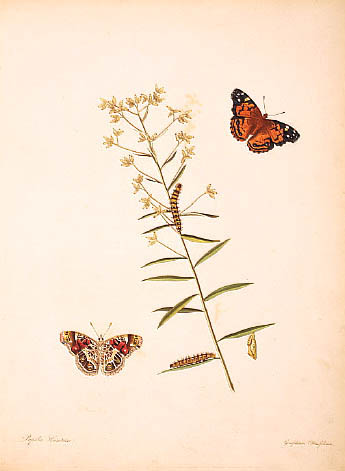
Abbot first sketched his drawings in pencil and then delicately hand colored them in pleasing, varied combinations of watercolors. Whereas Bartram made individual portraits of certain plants and animals, Abbot tended to stylize and simplify shapes and to emphasize patterns. In 1797, 104 etchings after watercolors by Abbot appeared in The Natural History of the Rarer Lepidopterous Insects of Georgia. Published in London in two volumes and edited by Sir James Edward Smith of the Linnean Society of London, Abbot’s book was the first significant publication on North American insects.
By 1806 Abbot was living in the Savannah area, in Chatham County. He went on several collecting trips with his friend Alexander Wilson, whose American Ornithology was published in 1808-14, and furnished Wilson with specimens and watercolors. By 1816 Abbot had returned to Chatham County and had begun drawing for William Swainson the life stages of insects not featured in his 1797 work; the project took two years but was never published. In 1818 Abbot was living in Bulloch County, inland from Savannah, where he remained until he died, around 1840. His watercolors number more than 5,000 and are housed in numerous collections around the world.
Portraiture
Portraits of Native Americans
Natural history drawings, the prints made after them, and engraved and etched views of Georgia are highly significant because they record the early development of the state. Portraiture, drawn or printed, also played an important early role, especially in documenting Native Americans. For example, an early printed portrait of Tomochichi, leader of the Yamacraw Indians in the Savannah River region, and his nephew Toonahowi was made around 1734-35, when the chief and an entourage, including James Oglethorpe, traveled to London to meet the Georgia Trustees. John Faber Jr. engraved the mezzotint that depicts Tomochichi and his nephew in an elegant black-and-white work skillfully modeled after the painting by English artist William Verelst. Faber, from The Hague in the Netherlands, was one of the most accomplished mezzotint engravers in England. The process was especially suited to suggesting smooth, velvety tones and surfaces, made by burnishing outlines and details until they came into view on a rough, pitted copper plate and then inking and printing the plate in an etching press. Around the same time, Von Reck, painting in the New Ebenezer settlement, made a watercolor rendering of the Yuchi Indian chief Kipahalgwa.
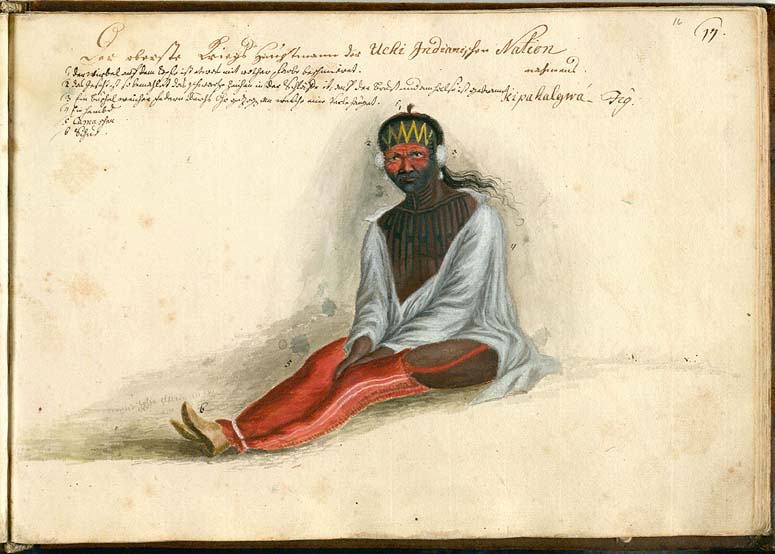
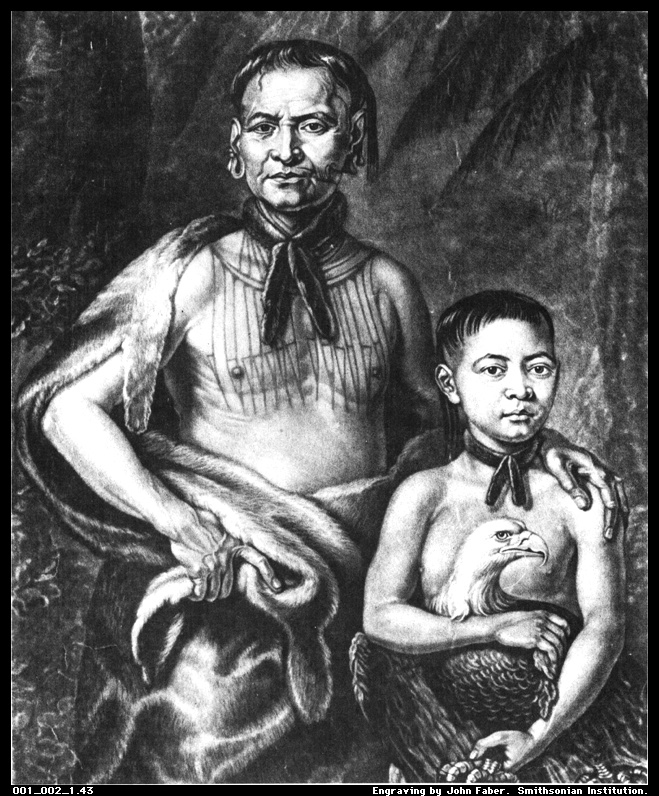
Much later, in 1833, the lithographic firm of Lehman and Duval in Philadelphia executed a lithograph of a portrait of Sequoyah, the Cherokee silversmith who had developed an alphabet of the Cherokee language. “Translating” a portrait in oil by Charles Bird King, the lithographer drew the portrait on stone, inked the heavy stone, and then printed the lithograph. The original painting was part of a series of oils, most now destroyed by fire, commissioned by Thomas Loraine McKenney, a federal superintendent of Indian affairs. The series portrayed tribal leaders who visited Washington, D.C., during a period of increasingly controversial discussions over the preservation of Native American cultures.
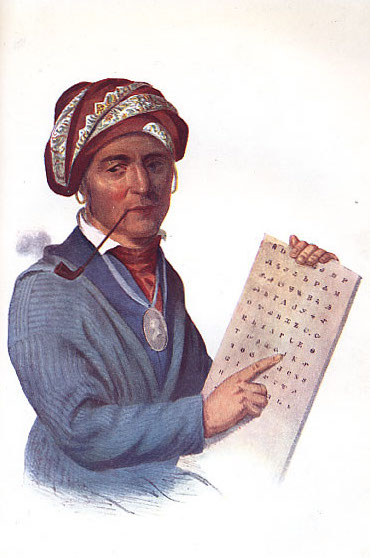
Commissioned Portraits
For the most part, however, from the mid-eighteenth through the nineteenth centuries, portraiture existed in Georgia as an art specially commissioned by Georgia patrons, and it was the most popular type of art in the state. Portraits of Georgians were numerous, as seen in miniature paintings in watercolor on ivory or paper, especially during the period from 1790 to 1830, and by pastel, watercolor, and pencil drawings on paper. These works are in addition to the larger, simultaneous field of portrait paintings in oil on canvas.
Most of the earlier portraits were created by traveling artists or artists with studios in such metropolitan areas as Savannah and Charleston, South Carolina, or in northern cities. For instance, Charles Willson Peale, based in Philadelphia, painted portrait miniatures of Georgians, including George Walton, around 1781. Peale’s son Raphaelle painted miniatures in Savannah, as did many artists. By the 1830s out-of-state portrait painters began settling in Georgia; they traveled to inland towns like Augusta and Macon, finding a clientele among the wealthy planters made rich by the cotton trade.
By the mid-nineteenth century, portraiture had expanded further in the state, with many oils and an array of strikingly lifelike portraits of well-to-do and middle-class Georgians drawn in watercolor and pastel, especially by unknown artists. In the late nineteenth century in Atlanta, by then the center for art in the state, portrait drawings were still popular with painters. Mary Bland Rogers Gregory, for instance, made crayon portraits there, and Lucy May Stanton and others created miniature paintings in the city. Their miniature paintings were part of the Arts and Crafts movement’s revival of the medium at the end of the century.
Landscape and City Views in the Early and Mid-Nineteenth Century
From the mid-eighteenth through the early nineteenth centuries, spurred by the Romantic movement in the arts, drawn and printed views of the countryside, gardens, parks, architectural ruins, and cities increased in popularity in England and continental Europe. Subsequently, in the early nineteenth century, picturesque views of America’s countryside, propelled by an admiration for an untamed and largely unseen landscape, became popular. Consequently, the number of drawn and printed views of Georgia increased during this time.
Joshua Shaw
The English landscape painter Joshua Shaw traveled in Georgia as part of his East Coast sketching tour for his major print publication, Picturesque Views of American Scenery, the first series of printed views to be published in the United States. While traveling, Shaw sketched views and took subscriptions for prints that would be based on paintings he made after these sketches. Published in Philadelphia in 1819-21 by M. Carey and Son, the portfolio of nineteen prints comprised hand-colored aquatints made by London-born printmaker and publisher John Hill. Aquatints (engravings made with a powdery resin fused to the copper plates) were highly popular for their capacity to create the effects of watercolor and were numerous in England and in Europe during these years.
Hill’s aquatints showed mostly “beauties of notable scenery.” In Shaw’s words, the series concentrated on the “beautiful and sublime” aspects of nature in an America that remained unrevealed to the world. The views developed out of the older eighteenth-century European topographical tradition, with its preference for picturesque and sublime subjects for art. Georgia scenes that appeared in the series included the great fire of 1820 in Savannah, shown at a considerable distance against a dramatic landscape of silhouetted trees and a brilliantly lit sky, as well as a windy, storm-threatened scene of Spirit Creek in the secluded countryside near Augusta.
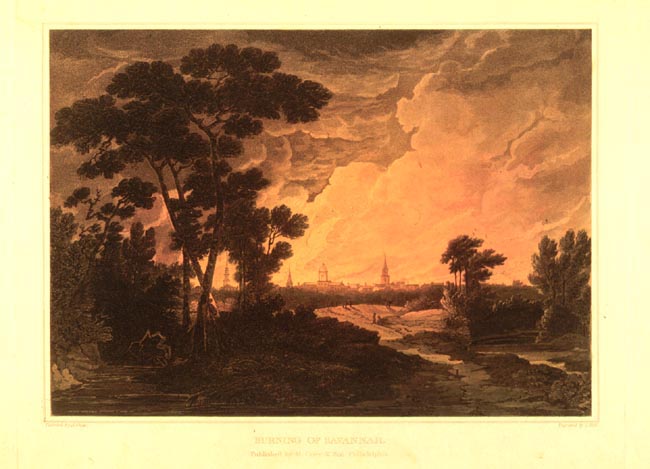
Prints and Drawings in Savannah
Printed views of Savannah, particularly of its architecture, were published in early commercial directories of the young America and in histories, including History and Topography of the United States, which was edited by John Howard Hinton and published in London in 1830-32. William Goodacre, who taught drawing in New York City, drew views of Savannah buildings that were engraved in London and published in Hinton’s History. In 1855 the lithographic firm of Endicott and Company in New York published a sweeping view of Savannah, drawn by Charles Parsons after a painting by John William Hill, that was studded with innumerable trees amid homes, businesses, and churches. Bull Street and the Pulaski Monument on Monterey Square are prominently featured in this view.

Along with an interest among visiting artists in making drawn and printed views of Savannah, an interest developed among prominent Savannah residents in collecting prints. The historian William Dunlap, for example, writes in his diary in April 1820 that Joshua Shaw had just come from Savannah, reporting that he had attracted more subscribers to his print publication there than in any other place in the United States. In specific examples of print ownership, we know that George Welshman Owens of Savannah owned stipple engravings (engravings using a dot pattern to show shadows and modeling) by the popular printmaker Francesco Bartolozzi after fashionable European artists, including Angelica Kauffman. In another example, mezzotints after Lavinia, countess of Spencer, that were published in London have descended through the Nightingale family in Savannah.
Views of Georgia
Engravings of sites in other Georgia cities and towns were also being created, including the neo-Gothic state capitol building at Milledgeville; the First Presbyterian Church in Augusta, published in 1854; and the University of Georgia campus in Athens, published in Gleason’s Pictorial Drawing-Room Companion in 1854.
Artists residing in Georgia also began making views. For instance, the landscape painter Joseph Louis Firmin Cerveau, born in Turkey, lived in Savannah and in 1837 painted his large View of Savannah in watercolor. During the same years in Penfield (Greene County), English-born Thomas Addison Richards, having lived in New York and Charleston, painted in the manner of the Hudson River school from 1838 to 1844. His atmospheric, romantic landscapes show a reverence for both the beauty and the awesome forces of nature. Richards also taught painting in oils as well as “Landscape and Flower drawing in watercolors; Sepia and India Ink tinting; Pencil drawing and Perspective.” By 1845 Richards had resettled in New York, and by 1848 he was an associate member of the National Academy of Design in New York, serving as its corresponding secretary for forty years.
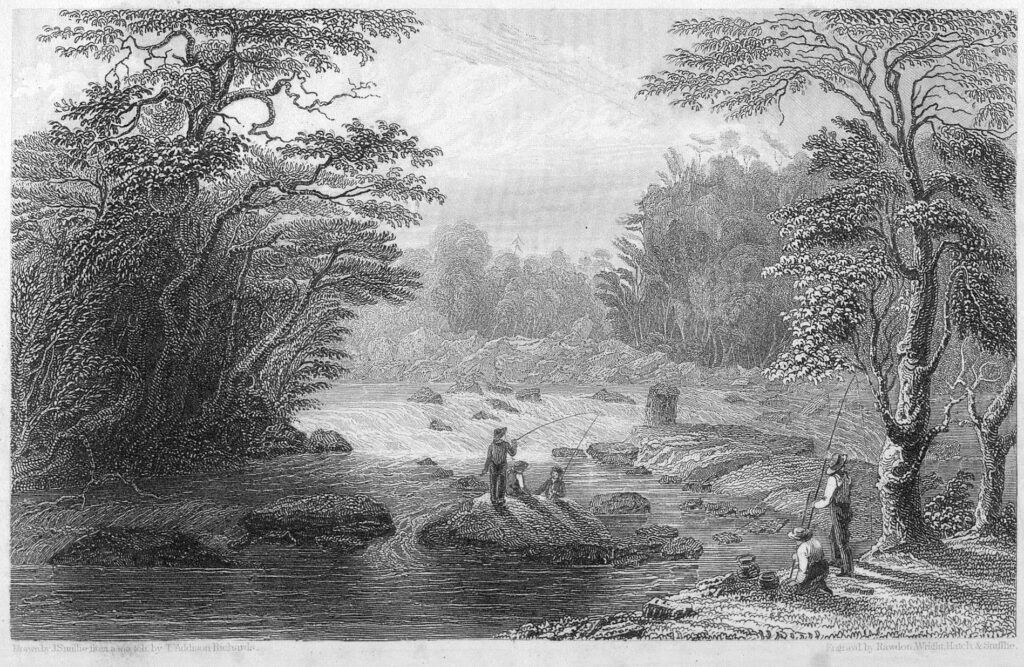
Richards’s drawings of the region, while attracting many admirers, apparently formed the basis of his oil paintings. However, his pencil sketches were often “translated” by others into prints, and it is for these sketches and prints that he is best known. In a continuation of the tradition of picturesque views, many of his sketches appeared as small steel engravings in the book Georgia Illustrated, in a Series of Views Embracing Natural Scenery and Public Edifices, published in 1842 in Penfield by Richards and his brother.
In 1844 Graham’s Magazine published an engraving by James Smillie, the principal engraver after Hudson River school paintings, and others after Richards’s sketch of the Nathanael Greene monument in Savannah. Richards also made other sketches that were later engraved and wrote articles for the Southern Literary Gazette, which was published in Athens by his brother beginning in 1848. In 1853 wood engravings after his drawings were also published in the article “The Landscape of the South” in Harper’s New Monthly Magazine, in which Richards wrote of such natural attractions as Toccoa Falls, comparing them to such better-known sites in the Northeast as Kaaterskill Falls.
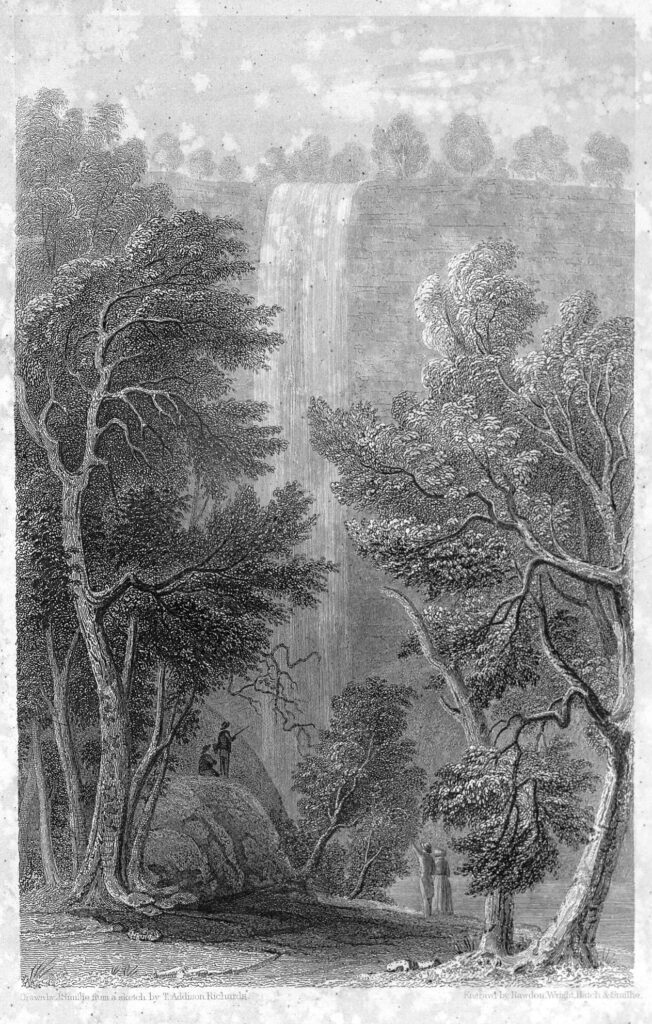
Illustrations for Popular Books and Magazines
In the middle of the nineteenth century, artistic and cultural interest in the landscape of the southern states found an outlet in individual prints and in printed illustrations in travel books and general magazines geared toward a new audience of readers. Curiosity about the region’s people and their character and customs was widespread during this period, and narratives with printed illustrations of real, fictional, and semifictional southerners, including Georgians, appeared in popular publications geared toward the middle class.
The Library of Humorous American Works series featured Major Jones’s Courtship, a highly popular novel published in 1844 in Philadelphia about the amusing life of a rural Georgia militia officer. The novel was written by William Tappan Thompson with wood-engraved illustrations designed by Felix Octavius Carr Darley; additional volumes followed. Travel accounts were also published, including landscape architect Frederick Law Olmsted’s A Journey in the Seaboard Slave States, and appeared in 1856 in New York with wood engravings designed by Olmsted.
In the 1860s, especially during and after the Civil War (1861-65), wood engravings documenting Georgia scenes appeared in national and international magazines and in pictorial books. Harper’s Weekly, for instance, carried wood engravings of the Union’s Atlanta campaign. During the war, northern lithographic firms made prints of federal activities in Georgia. Currier and Ives, for instance, made a few prints depicting battles in Georgia, including scenes of Jonesboro, Chickamauga, and Atlanta.
In the 1870s, after the war was over, curiosity about life and scenery in the South became intense, and illustrated magazines featured numerous articles on the region. For example, highly detailed wood-engraved and steel-engraved scenes of the South, including Georgia, made after on-the-spot sketches, were featured in Picturesque America, edited by William Cullen Bryant and published in New York in 1874, after being first published as a series in Appletons’ Journal in 1870-72. The theme relied on the tradition of travel prints and drawings already familiar to the educated American public. In another example, commercial scenes of Georgia, including views of Augusta and Atlanta and of a cotton mill in Columbus, appeared as wood engravings made after drawings by James Wells Champney in a series of articles entitled “The Great South,” written by Edward King for Scribner’s Monthly in 1873-74 and later published as a book in 1875.
In the late nineteenth century a few artists living in Georgia became associated with making illustrations for popular publications. One of the major ones, Horace Bradley, born in Dublin, Georgia, grew up in Atlanta, and soon started drawing for such national newspapers as Frank Leslie’s Illustrated Weekly. In 1881 he moved to New York temporarily and drew for New York magazines, especially Harper’s Weekly, for which he would become a prominent illustrator.
In 1882 and 1883, back in Atlanta, Bradley organized the first loan exhibitions of art in that city, and in 1883 he opened the Atlanta Art School. Around 1886 he left Atlanta again for New York, where he became president of the Art Students League and art editor for Harper’s publications. As chief of the fine arts department of the Cotton States and International Exposition in Atlanta in 1895, Bradley organized the art exhibitions shown in the Fine Arts and Woman’s Buildings. He died the following year.
James Henry Moser, another major illustrator of this period, is also associated with Georgia. In 1879 the Canadian-born Moser, who was already sending sketches of African Americans to Harper’s, Century, and other magazines in New York, settled in Atlanta. Commissioned by Joel Chandler Harris, Moser made illustrations for Harris’s Uncle Remus stories, published in 1881 in New York. Moser illustrated enslaved life as generally peaceful and fun-loving, a stereotypical view that finds its counterparts in caricatures and social satires of Blacks, of the Irish, and of Jews published in popular national magazines of the period. Moser’s sketches of African Americans, however, drawn in his studio in Atlanta, reveal a more sensitive approach to his subjects.
Beginning in 1882, Moser headed the art department at Miss Ballard’s Seminary in Atlanta. While in Atlanta, Moser, a painter whose delicate, tasteful watercolors of interiors and landscapes were in demand, exhibited his work at the American Water Color Society and at the National Academy of Design, both in New York City. By 1887 he and his family lived in Washington, D.C., where Moser drew ink sketches for newspapers in New York and eventually taught watercolor at the Corcoran School of Art, wrote art criticism for the Washington Post, and presided over the Washington Water Color Club. In summers he painted in his studio in Cornwall, Connecticut.


